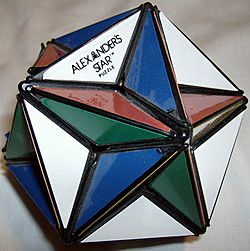Alexander's Star facts for kids
 |
|
| Type | Puzzle |
|---|---|
| Inventor(s) | Adam Alexander |
| Company | Ideal Toy Company |
| Country | United States |
| Availability | 1982–present |
Alexander's Star is a fun puzzle that looks like a big, spiky star. It's a lot like the Rubik's Cube, but it has a unique shape called a great dodecahedron. This cool puzzle was invented by Adam Alexander in 1982.
How Alexander's Star Works
This puzzle has 30 pieces that can move. These pieces spin in groups of five around the star's points. The main goal of the puzzle is to move the pieces until each star shape on the surface is surrounded by five faces of the same color. Also, the stars on opposite sides of the puzzle should end up with the same color.
Imagine the puzzle has different flat sections, even though it's spiky. When you solve it, each pair of these flat sections should be just one color. It can be tricky because some pieces sit on top of these sections, and they might be different colors.
The puzzle doesn't always turn super smoothly because of its special design. It's part of the challenge!
How Many Combinations?
Alexander's Star is a very complex puzzle! There are a huge number of ways its pieces can be mixed up. Even though it has 30 moving pieces, some rules about how they can move mean the total number of possible combinations is slightly less than you might guess.
The exact number of possible combinations is 72,431,714,252,715,638,411,621,302,272,000,000. That's a really, really big number! It's about 72.4 decillion in the short scale (how numbers are named in places like the United States) or 72.4 quintilliard in the long scale (used in some other countries). This means it would take a very long time to try every possible combination!
See also
 In Spanish: Estrella de Alexander para niños
In Spanish: Estrella de Alexander para niños


